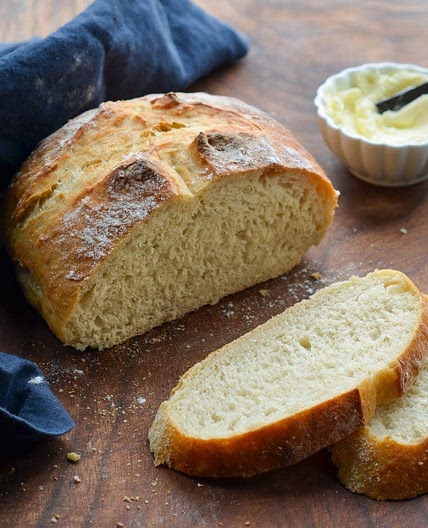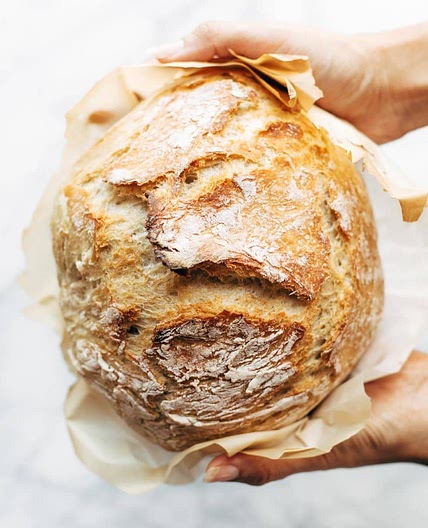By Phyllis Bergenholtz
The New Artisan Bread in Five Minutes a Day Master Recipe! (Back to Basics updated) - Artisan Bread in Five Minutes a Day
Updated at: Thu, 17 Aug 2023 13:17:47 GMT
Nutrition balance score
Good
Glycemic Index
75
High
Nutrition per recipe
Calories3302.2 kcal (165%)
Total Fat8.9 g (13%)
Carbs692.3 g (266%)
Sugars2.4 g (3%)
Protein93.7 g (187%)
Sodium5778.1 mg (289%)
Fiber24.5 g (87%)
% Daily Values based on a 2,000 calorie diet
Ingredients
0 servings
3 cupswater
lukewarm, you can use cold water, but it will take the dough longer to rise just don’t use hot water or you may kill the yeast
1 tablespoongranulated yeast
you can use any kind of yeast including instant, “, quick, ”, rapid rise, bread machine, active dry, or fresh cake yeast ’ ed with red star yeast and a new premium called platinum a ugh starter
1 tablespoonskosher salt
adjust to suit your taste or eliminate it all together find more information here
6 ½ cupsall-purpose flour
we’ve always tested our recipes with typical supermarket flour if you use a higher protein flour check here
Instructions
Mixing the Dough
Step 1
In a 5 or 6 quart bowl or lidded dough bucket (the lid is sold separately), dump in the water, and add the yeast and salt.
Step 2
Because we are mixing in the flour so quickly it doesn’t matter that the salt and yeast are thrown in together.
Step 3
Dump in the flour all at once and stir with a long handled wooden spoon or a Danish Dough Whisk, which is one of the tools that makes the job so much easier!
Step 4
Stir it until all of the flour is incorporated into the dough, as you can see it will be a wet rough dough.
Step 5
Put the lid on the container, but do not snap it shut. You want the gases from the yeast to escape. (I had my husband put a little hole in the top of the lids so that I could close the lids and still allow the gases to get out. As you can see it doesn’t take much of a hole to accomplish this.)
Step 6
Allow the dough to sit at room temperature for about 2 hours to rise. When you first mix the dough it will not occupy much of the container.
Step 7
But, after the initial 2 hour rise it will pretty much fill it. (If you have decreased the yeast you will have to let it go longer than 2 hours.) DO NOT PUNCH DOWN THE DOUGH! Just let it settle by itself.
Step 8
The dough will be flat on the top and some of the bubbles may even appear to be popping. (If you intend to refrigerate the dough after this stage it can be placed in the refrigerator even if the dough is not perfectly flat. The yeast will continue to work even in the refrigerator.) The dough can be used right after the initial 2 hour rise, but it is much easier to handle when it is chilled. It is intended for refrigeration and use over the next two weeks, ready for you anytime. The flavor will deepen over that time, developing sourdough characteristics
To Make a Loaf
Step 9
The next day when you pull the dough out of the refrigerator you will notice that it has collapsed and this is totally normal for our dough. It will never rise up again in the container.
Step 10
Dust the surface of the dough with a little flour, just enough to prevent it from sticking to your hands when you reach in to pull a piece out.
Step 11
You should notice that the dough has a lot of stretch once it has rested. (If your dough breaks off instead of stretching like this your dough is probably too dry and you can just add a few tablespoons of water and let it sit again until the dough absorbs the additional water.)
Step 12
Cut off a 1-pound piece of dough using kitchen shears* and form it into a ball. This video shows the technique for shaping this very wet dough.
Step 13
Place the ball on a sheet of parchment paper… (or rest it on a generous layer of corn meal on top of a pizza peel.)
Step 14
A pair of Shears works well.
Step 15
Preheat the oven to 450 degrees with a Baking Stone on the center rack, with a metal broiler tray on the bottom (never use a glass vessel for this or it will shatter), which will be used to produce steam. (The tray needs to be at least 4 or 5 inches away from your stone to prevent it from cracking.)
Step 16
Cut the loaf with 1/4-inch slashes using a very sharp serrated knife. (If your slashes are too shallow you will end up with an oddly shaped loaf and also prevent it from splitting on the bottom.) If your dough is collapsing when you make the slashes, it may be that the dough has overproofed or your knife it dull and dragging the dough too much.
Step 17
Slide the loaf into the oven onto a preheated stone (the one I’m using is the cast iron) and add a cup of hot water to the broiler tray. Bake the bread for 30-35 minutes or until a deep brown color. As the bread bakes you should notice a nice oven spring in the dough. This is where the dough rises. To insure that you get the best results it is crucial to have an Oven Thermometer to make sure your oven is accurate.
Step 18
If you used parchment paper you will want to remove it after about 20-25 minutes to crisp up the bottom crust. Continue baking the loaf directly on the stone for the last 5-10 minutes.
Step 19
Allow the loaf to cool on a rack until it is room temperature. If you cut into a loaf before it is cooled you will have a tough crust and a gummy interior. It is hard to wait, but you will be happy you did! Make sure you have a nice sharp Bread Knife that will not crush the bread as you cut. Or you can tear it apart as they do in most of Europe.
Step 20
If you have any leftover bread just let it sit, uncovered on the cutting board or counter with the cut side down. If you cover a bread that has a crust it will get soggy
Step 21
https://artisanbreadinfive.com/2013/10/22/the-new-artisan-bread-in-five-minutes-a-day-is-launched-back-to-basics-updated/
View on artisanbreadinfive.com
↑Support creators by visiting their site 😊
Notes
4 liked
1 disliked
Easy
Fresh
Go-to
Makes leftovers
There are no notes yet. Be the first to share your experience!











